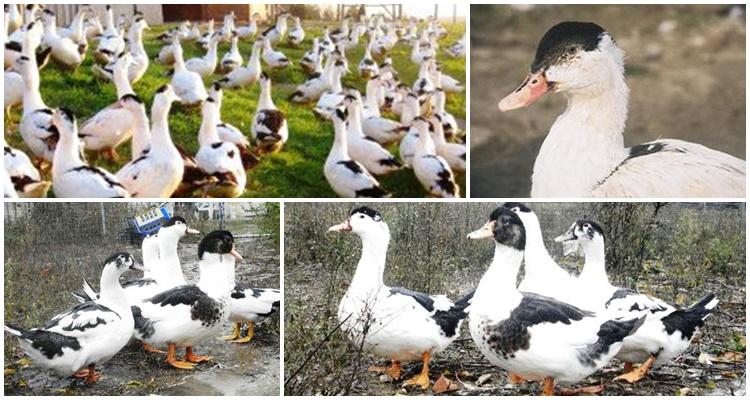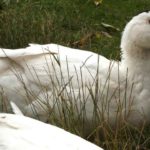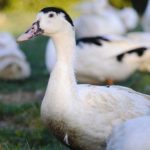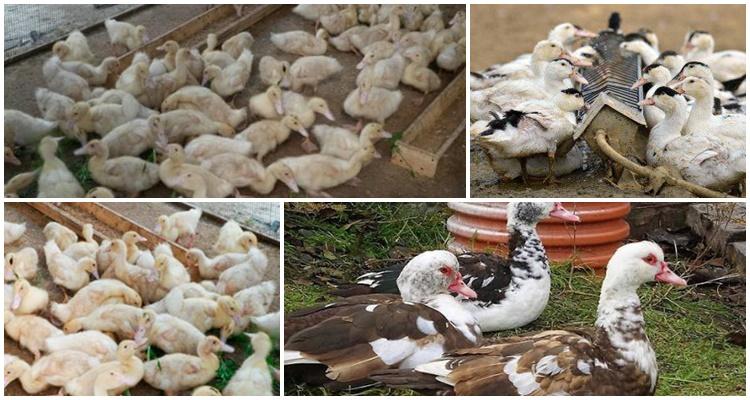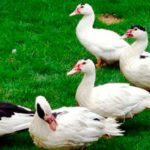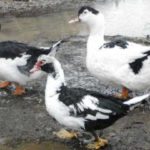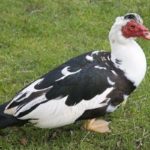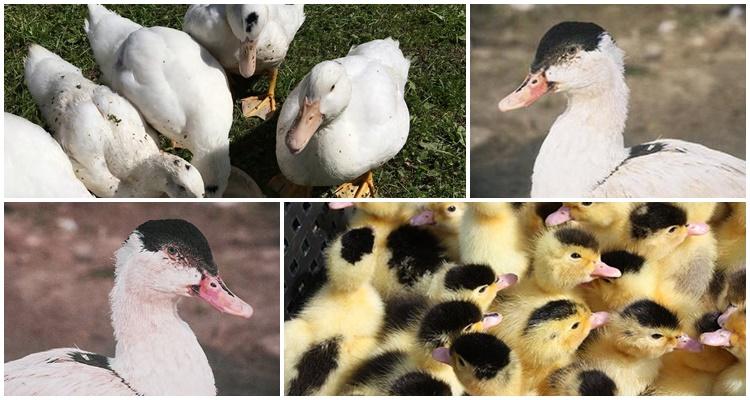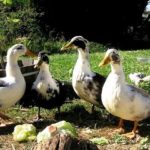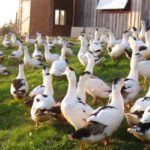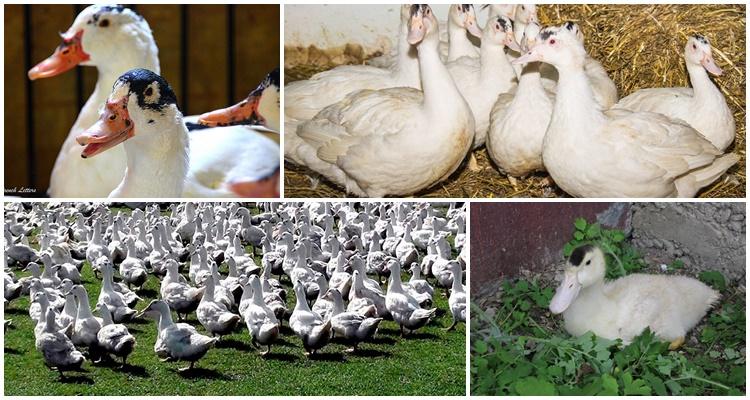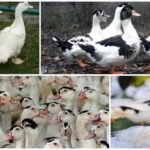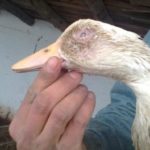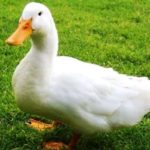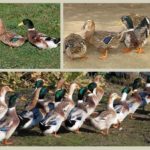Mulards are called hybrid birds obtained as a result of the work of geneticists. They received the best qualities from their parental line. The main purpose of keeping mulards is to obtain dietary meat. Malards are purposefully raised for further preparation of foie gras. Liver, prepared in a special way, is considered a traditional delicacy of French cuisine.
- Origin of ducks
- Description and characteristics of mulards
- Advantages and disadvantages
- Breed varieties
- Features of keeping and caring for hybrids
- Breeding and raising young animals
- What diseases do they suffer from?
- Possible problems during cultivation
- How to distinguish a mulard duckling from other ducklings
- Business
Origin of ducks
Mulards were obtained as a result of selective crossing between wild species of Muscovy ducks and domesticated Pekin ducks. The hybrid, which became known as the mulard, is a cross between a wild duck drake and a domestically bred hen. To obtain a meat breed, other breeds of domestic duck can be crossed, except Peking, but the parental line is always based on the use of a drake gene from the Indo duck breed. In terms of taste, mulard meat is similar to goose meat; the size and appearance of carcasses after slaughter are almost the same. Mulards and geese have in common a feature that characterizes the taste of the liver. Mulard liver replaces goose liver without loss of quality.
Reference! A feature of mulards is sterility; they are not capable of reproducing offspring, which is why the breed is often called “birds for one season.”
Description and characteristics of mulards
Adult ducks reach the weight 7 kilograms. Females grow 0.5 kg less than males. With dense feeding, the birds' weight increases over the weeks. In 2 months, a duck can be fattened by 2 kilograms. Table of weight gain in birds by month:
| Bird age | Bird weight |
| By 3 months | About 4 kilograms |
| After 6 months | More than 4 kilograms |
| By 1 year | 7 kilograms |
Mulards in appearance look like large Peking ducks. They have snow-white plumage; there is often a black spot on the head, which indicates that they belong to the breed. The feature that distinguishes Mulards from Pekings is the rapid gain of muscle mass. Peking women gain fat, but their muscle mass remains the same.
The body of the standard Mulard duck is large, with wings tightly pressed to the sides.The bird moves slowly, calmly, does not get into fights with neighbors, and does not provoke other birds. Females are known for their cleanliness, but their brooding instinct is almost undeveloped.
Birds that develop dark feathers in their tail plumage are called mulattoes. This means that mistakes were made when crossing along the parental line. Experienced breeders strive to purchase birds with white plumage and a black spot on the head.
Advantages and disadvantages
Mulards are kept to produce tasty meat. Requirements for housing conditions are related to the advantages and disadvantages of the breed.
Breed varieties
Purebred Mulards are birds with white plumage and a black spot on the head. But when several lines are mixed, ducks with different plumage and combinations of qualities are obtained. This happens if black musk drakes and females with white plumage were used during crossing.
Mulards began to be grown in the south of France. The goal of the French breeders was to produce meat comparable in taste to Peking duck meat, but with less fat. The Orvia company is a leader in raising interspecific turkey ducks. The company supplies more than 70 percent of the birds on the market.
The largest among the mulards are birds whose snow-white plumage turns to a blue tint. Against the background of the plumage, the colored red beak looks especially noticeable. The weight of an adult individual of this species reaches 7-7.5 kilograms. The yield of clean meat is at least 70 percent. Such an individual can be obtained by crossing a snow-white drake with a pure white Peking duck.
Reference! For crossing, choose a musk breed and any domestic waterfowl breed. In addition to the Peking duck, they take Bashkir or White Russian birds.
Features of keeping and caring for hybrids
The lifespan of mulards is limited to 1 or 1.5 years. In order to start slaughtering a bird, it must reach a certain height and weight. The best option is to bring the bird to a weight of 4-6 kilograms. To bring the bird to a suitable state, it is necessary to create conditions for full growth and development:
- kept at a temperature range from +16 to +25 degrees, humidity range from 60 to 70 percent;
- providing birds with a free run;
- providing a small container of water so the bird can bathe;
- free access for birds to drink;
- balanced diet;
- absence of drafts in the room where the birds are kept.
Information! Mulards do not tolerate cold well, so owners strive to send them to slaughter before frost sets in.
Breeding and raising young animals
Domestic crossbreeding is carried out between a Muscovy drake and several Pekin ducks. This process requires special control and the participation of experienced breeders. After crossing birds, it is recommended to keep the resulting eggs in an incubator for 28-30 days until the offspring appear.
It is customary to purchase young animals during April and early May, so that the bird is fully strengthened by the beginning of summer and gains weight before the onset of cold weather. You can get Mulard eggs at home by crossing Muscovy and Peking ducks. At the same time, there is a high probability of a violation at the gene level, so breeders prefer to buy ducklings from industrialists.
Ducklings in the first days of life are kept under special conditions:
- the bottom of the box or the floor of a small room is lined with disposable diapers, which are changed several times a day;
- the first day a lamp with dim artificial light is left above the ducklings, the air temperature is maintained at +30 degrees;
- chicks are given a weak solution of manganese for 2-3 days, this protects against infection with infectious diseases;
- gradually daylight hours and air temperature are reduced by 2-3 divisions;
- by day 10, the birds need a temperature of +22 degrees, while the light intensity should be reduced to natural.
In the first hours of life, the chicks are fed boiled eggs. The yolks and whites are colored and sprinkled on top of the duck. This helps develop the grasping reflex. By the 2nd and 3rd days of life, the chicks should learn to feed on their own. To organize the feeding process, it is necessary to provide each bird with access to a feeder. There is a bar on the feeder so that the young animals do not lift their heads up and injure their necks when feeding.
From the 10th day of life until they reach 1 month of age, ducks are fed with mixed feed and grass. Starting from the age of one month, birds are given high-calorie food twice: in the morning and in the evening. Mineral and vitamin supplements are added to food.
Attention! To make food digest better, they add river sand or fine gravel.
What diseases do they suffer from?
Mulards are valued for their high immunity, but its performance decreases noticeably when the air temperature drops by several degrees.
Common diseases of the breed:
- Feather pecking. At any stage of growth, birds may begin to pluck each other's feathers. There may be several reasons for the problem to occur. Individuals are sensitive to disturbances in humidity. Excessive dryness or high humidity can provoke bird aggression. Poor diet, lack of salt supplement, lack of water - this often leads to birds nibbling each other.
- Aspergillosis. An infection of fungal origin that penetrates to birds through contaminated bedding or feeders. The duck becomes apathetic, loses weight, and does not touch the food. The problem can be solved by prescribing antibacterial therapy. If treatment is not started in a timely manner, the consequence of the disease is complete paralysis.
- Cloacite. A dangerous disease characterized by inflammation of the cloaca. Inflammation is caused by the presence of infection in the body or violation of the rules of care. Due to inflammation, the duck experiences discomfort, and purulent discharge begins from the anus. To save the bird, treat the cloaca with iodine solution and lubricate the anus with zinc ointment.
- Viral hepatitis. A serious disease that affects the liver, which is especially dangerous for mulards raised for sale for foie gras. Young ducklings are susceptible to hepatitis.When infected, birds huddle together, begin to fall on their sides, and twist their necks. Many chicks develop conjunctivitis and shortness of breath at the initial stage. A measure to prevent hepatitis is to maintain cleanliness in the poultry house.
Information! A preventive measure to support immunity is timely vaccination. Ducklings are vaccinated at the age of 5 days.
Possible problems during cultivation
Home breeding involves following basic rules. Violation leads to the formation of typical problems:
- Birds begin to peck at each other if there are not enough vitamins and minerals in the diet. This is a fairly common occurrence in mulards; the reaction is especially typical for domestic animals. Violation of containment conditions may cause a reaction. To avoid this, it is advised to monitor your diet. In aggressive individuals, beak trimming is practiced.
- If the bird is not provided with a container of water, it may begin to behave restlessly. This is due to the cleanliness of the breed.
- Hatching at home is rarely practiced. This is due to the low survival rate of chicks, which is 55 percent. To hatch ducklings obtained after independently crossing the Muscovy and Peking breeds, it is necessary to use an incubator.
How to distinguish a mulard duckling from other ducklings
To get a purebred mullard, it is customary to cross musks and waterfowl Peking ducks. It is quite difficult to distinguish mullard ducklings from muskies.
When purchasing ducklings from breeders, you should pay attention to the following data:
- Mulard ducklings grow faster than their relatives;
- there is a black spot on the head of purebred chicks;
- the tails of the chicks of this breed are raised up, while the tails of the indo-ducks are lowered down;
- Unlike Pekin or mute ducklings, ducklings are calm, not loud, do not hiss and do not get into fights.
Business
Poultry farming begins with drawing up a business plan and planning costs. The goal of any business is the opportunity to make a good profit, so calculations are made in advance. The business plan includes the following data:
- cost of consumables for building a poultry house;
- the cost of feed, considering that mulards are unpretentious, but need high-calorie feed to quickly gain weight;
- the presence of associated expenses, which include payments for vaccinations, veterinarian services, and the purchase of vitamin and mineral complexes.
The breed is raised for meat production over one season, so the market must be taken care of in advance. Meat and liver are purchased by large companies that supply products to restaurants and cafes.
When receiving direct income without intermediaries, it is necessary to establish a connection with restaurant kitchens directly. In this case, it is important to provide for the possibility of storing meat while ensuring sanitary and hygienic standards.

